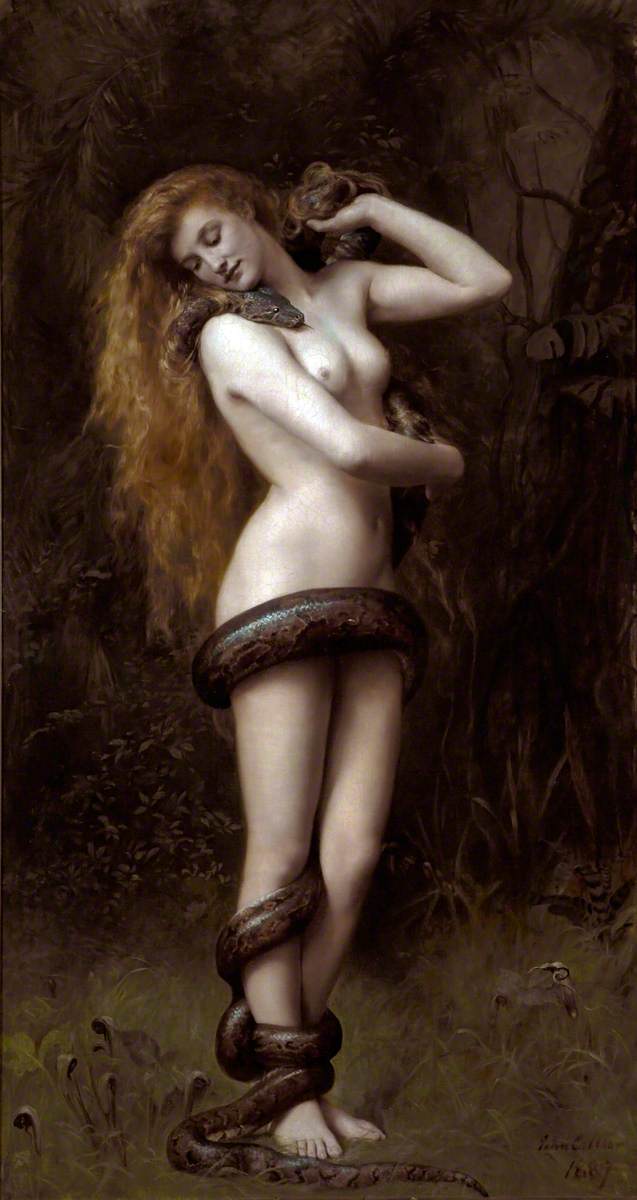Poetry Break: "Succubus"
 The image to the right comes to you courtesy of Wikipedia's John Collier Gallery. Collier (1850-1934) was a British artist who painted in the pre-Raphaelite style.
The image to the right comes to you courtesy of Wikipedia's John Collier Gallery. Collier (1850-1934) was a British artist who painted in the pre-Raphaelite style.This particular painting is titled Lilith, and it dates from 1892. She appears here with a snake, which -- I'm guessing -- is intended to visually link her to Satan and his temptation of Eve.
The link derives from a Medieval legend that Lilith was the first wife of Adam. According to that legend as recounted in The Alphabet of Ben Sira, an anonymous Jewish text probably dating somewhere between 700 and 1000 A.D., Lilith refused to submit sexually to Adam if this meant lying below, stating: "I will not lie below." She then uttered the Hebrew name of God and flew off into the air, apparently becoming a night demon, as her name implies.
In some Kabbalistic works, Lilith is identified as the mate of Samael, whom readers of Gypsy Scholar have already met.
Possibly deriving from the Ben Sira passage just cited, perhaps due to the sexual element -- but I'm again just guessing -- Lilith has sometimes been associated with the Medieval figure of the succubus, which is etymologically problematic since the term "succubus" comes from the Latin "sub-" + "cubare," meaning "to lie under," which is precisely what Lilith refused to do.
According to Medieval legend, a succubus was a female demon who came to sleeping men during the night to seduce them during their dreams. The Malleus Maleficarum, published in 1487 and purporting to explain all about witchcraft and how to vanquish it, states that the succubus would collect semen from the men whom they seduced and give it to an incubus, who would use it to impregnate sleeping women, producing children susceptible to demonic influence.
No doubt, this is all fascinating, but I'll just stop here and offer my poem, which presents a succubus at work in seduction, though the dream is from the man's perspective -- not me, incidentally, for I've never experienced such a nightmare (thank God).
By the way, if literary descriptions of sexuality bother you, then you'll want to skip this poem.
I composed this poem around 1984, which will set the gears in some minds whirring, but don't read too much into the date or the narrative "I."Succubus
She slipped, alone, into my room
to moan low sighs upon my ear,
and catch me tangled in her hair,
and lull me in a sensual swoon.
I loved her softer in the night
than subtle hand, with light caress,
could stroke one leg to raise a dress
and brush a moistened inner thigh.
And as a wanton sybarite,
she pressed her body close to mine
and drank my love like warm red wine
as though to drink it fully dry.
Intoxicated with her charms,
I kissed, and kissed, her supple breasts,
till languished in quiescent rest,
I lingered long within her arms.


6 Comments:
Great poem. I would definitely give it two snaps.
I used to attend some local poetry slams called a "griot" around Montgomery. Your stuff would have fit right in.
Beautiful poetry. Funny how you should mention Lilith. I was thinking of her on Saturday when I wrote about the Nordic gods. C.S. Lewis also mentioned her; the White Witch of Narnia was supposed to be descended from Lilith.
What's this, a Gypsy Scholar Girl Wednesday? ;-)
By the way, I seem to recall reading a Phoenician apotropaic tablet from Arslan Tash which was supposed to guard against various monsters of the night, including "lilin" (plural). It's in volume three of Gibson's work on Semitic Inscriptions.
Ian, interesting! Thanks!
Ian Myles, I thought Lewis mentioned "Lilith" as an ancestor of the White Witch within the Narnia series. Unfortunately, my Narnia books, like too many others, are back in Canada, so I can't check.
Given that first Isaiah (and again, I don't have my books here to learn what the scholarly consensus is on that particular verse in terms of dating and provenance) is closer in time to the Arslan Tash tablet than to third millennium Akkadian inscriptions, I'd say that the Phoenician tablet provides much more immediate background for the Isaiah passage in question, although perhaps the littitu demons you mentioned were not so different.
Gabe, thanks for the praise. What are "snaps"? I've never been to a poetry slam -- don't they require spontaneous poetry? I'm not very articulate that way.
Saur Kraut, did you change your name from Saur alone? Anyway, thanks for the praise. I saw your stuff on the Nordic gods. The more English literature that I teach, then more that I realize how little I know about the Old English background. (Also, I wasn't familiar with the White Witch connection to Lilith, but growing up in the Ozarks left me oblivious to Lewis despite the strongly evangelical culture there.)
Nathan, I hadn't thought of this as a Gypsy Scholar Girl Wednesday. I did debate with myself about putting the Collier image up there, but I concluded that it doesn't serve prurient interests (or doesn't intend to), as my poem doesn't (or doesn't intend to), so I posted it. As for information about the Phoenician tablet, I am an ignorant man.
Ian, thanks for the praise and -- as always -- for the other information. You seem to have devoted your life to learning. On the discussion that you and Nathan are having on Lilith, lilin, and the lilittu-demons, you both know far more than I.
Jeffery Hodges
* * *
Post a Comment
<< Home